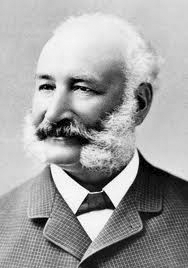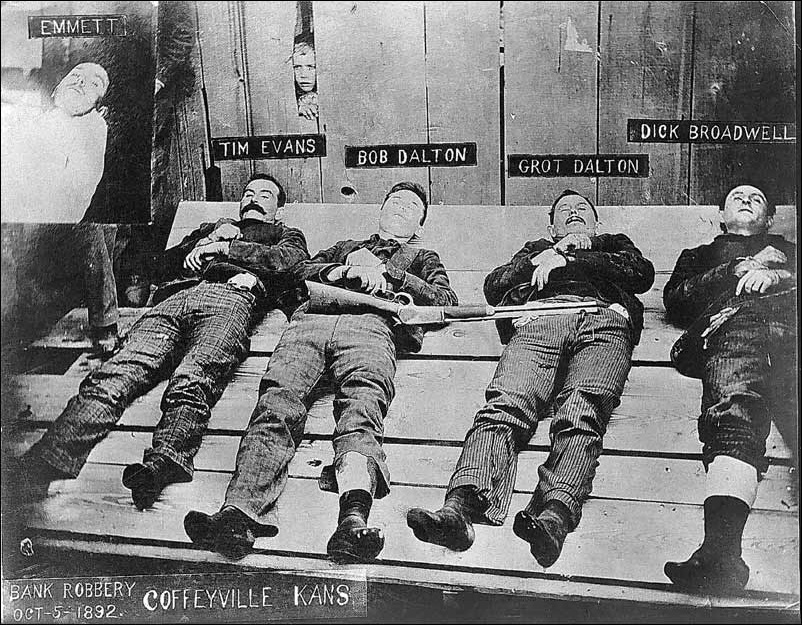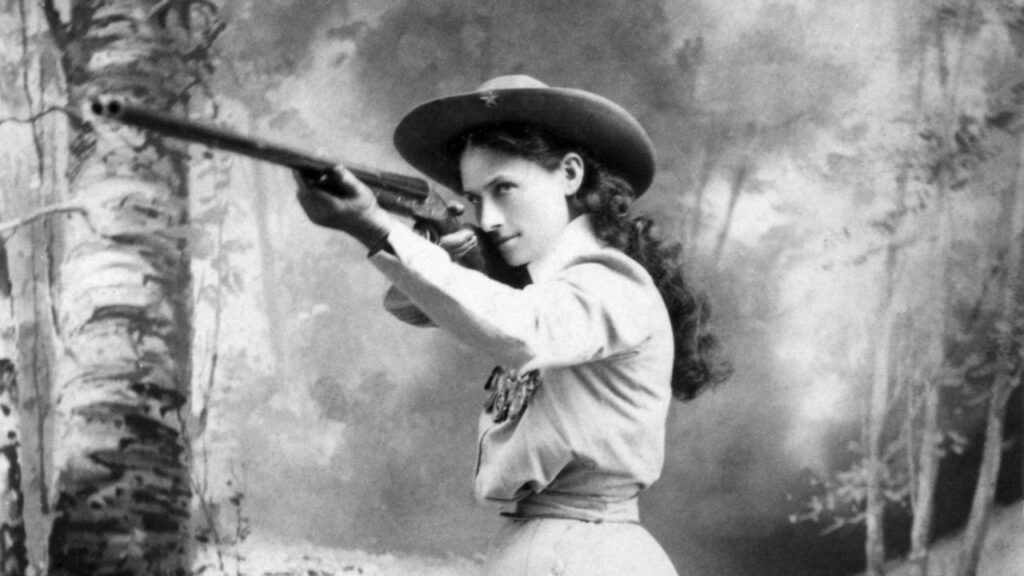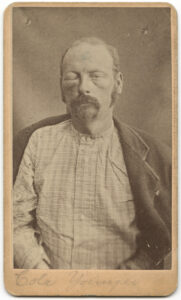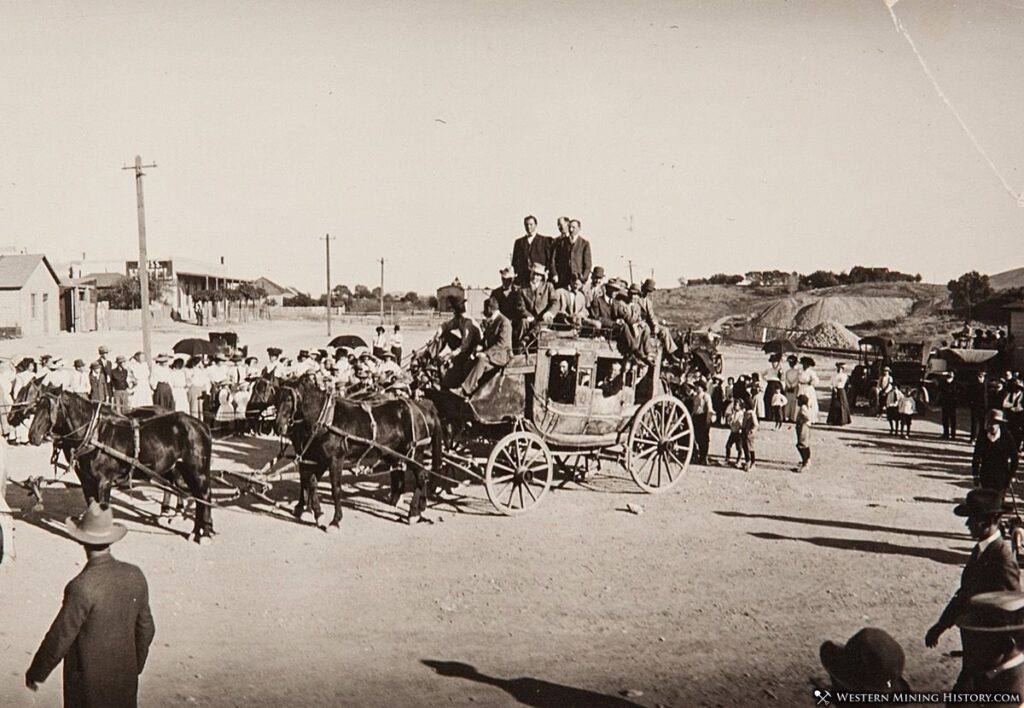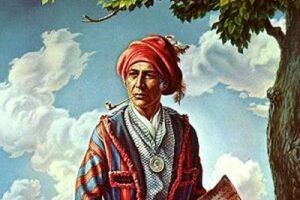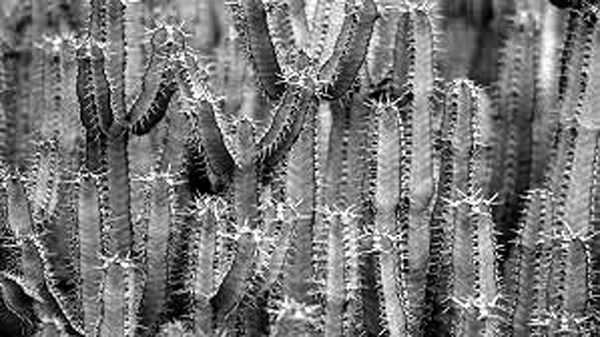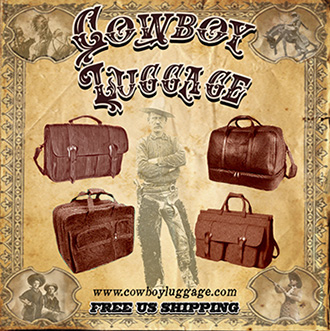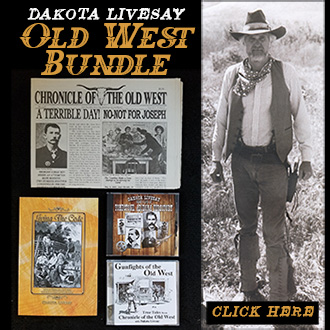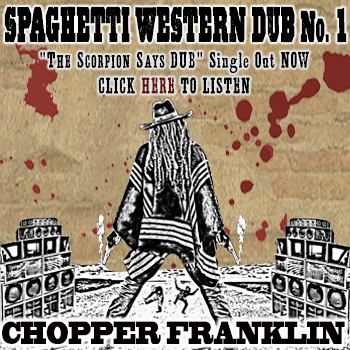The Sutro Tunnel at the Comstock Lode
On October 19, 1869, Prussian-born mining engineer, Adolph Sutro, began work on one of the most ambitious projects of the day: a four-mile-long tunnel through the solid rock at the Comstock Lode mining area. One of the richest silver deposits in the world, the Comstock Lode was discovered in 1859. But as miners sank shafts deeper into the rock, they began to encounter large amounts of water that had to be pumped to the surface at great expense. The Sutro Tunnel at the Comstock Lode would solve that problem.
Adolph Sutro’s idea was to tunnel through the rock of the neighboring Mt. Davidson and straight into the heart of the Comstock mine. Mine water would thus drain through the tunnel without need for expensive pumps, and the mining companies would also be able to use the tunnel to move men and ore in and out of the mine, greatly reducing transportation costs.
Although everyone agreed that Sutro’s tunnel would be a boon to the Comstock, progress slowed down by resistance from some of the major mining interests who feared that Sutro would use his tunnel to take control of the entire lode. Only after securing European capital was Sutro able to complete the $5-million project in 1878.
It was every bit as successful as Sutro though it would be. Unfortunately, by 1878, the richer sections of the Comstock Lode had been tapped out. However, Sutro was able to sell the tunnel at a fantastic profit. He moved to San Francisco where he became one of the city’s largest landowners as well as the city’s mayor from 1894 to 1896.
Wild Bill Longely
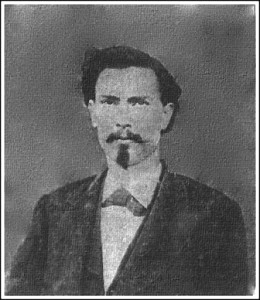 William Preston Longley was born on October 16, 1815. We don’t know his as William Preston, but as “Wild Bill”, a sadistic and murderous Old West gunman. Although little is know about him as a young man, it’s generally accepted that before he was 20 years old, Wild Bill Longley had already killed several men. He was short-tempered and he frequently killed simply because he believed he had somehow been slighted or insulted. He had a particularly strong dislike of blacks. Legend has it that Longley was once hanged along with a horse thief; but shots fired back by the departing posse cut his rope, and he was saved.
William Preston Longley was born on October 16, 1815. We don’t know his as William Preston, but as “Wild Bill”, a sadistic and murderous Old West gunman. Although little is know about him as a young man, it’s generally accepted that before he was 20 years old, Wild Bill Longley had already killed several men. He was short-tempered and he frequently killed simply because he believed he had somehow been slighted or insulted. He had a particularly strong dislike of blacks. Legend has it that Longley was once hanged along with a horse thief; but shots fired back by the departing posse cut his rope, and he was saved.
After killing a minister, Wild Bill fled Texas. But he was captured and returned to Lee County, Texas, where he was tried and found guilty of murder. Sentenced to hang, during his final days Longley became a Catholic, wrote long letters about his life, and claimed that he had actually only killed eight men. On the day of his execution, October 28, 1878, he climbed the steps to the gallows with a cigar in his mouth and told the gathered crowd that his punishment was just and God had forgiven him.
A noose was put around his neck, and he was hanged. Unfortunately, the rope slipped so that Longley’s knees hit the ground. After the hangman pulled the rope taut once more, Wild Bill slowly choked to death. It took 11 minutes before he was pronounced dead.
The Oklahoma Land Rush
On September 16, 1893, the largest land run in history begins with more than 100,000 people pouring into the Cherokee Strip of Oklahoma to claim their homesteads. With a single shot from a pistol the mad dash began, and land-hungry pioneers on horseback and in carriages raced forward to stake their claims to the best acres. The Oklahoma Land Rush was on.
 Ironically, not many years before that same land had once been considered worthless desert. Early explorers of Oklahoma believed that the territory was too arid and treeless for white settlement, but several suggested it might be the perfect place to resettle Indians, whose rich and fertile lands in the southeast were increasingly coveted by Americans.
Ironically, not many years before that same land had once been considered worthless desert. Early explorers of Oklahoma believed that the territory was too arid and treeless for white settlement, but several suggested it might be the perfect place to resettle Indians, whose rich and fertile lands in the southeast were increasingly coveted by Americans.
By the late nineteenth century, farmers had developed new methods that suddenly made this land valuable. The giant Cherokee Strip rush was only the largest of a series of massive “land runs” that began in the 1890s, with thousands of immigrants stampeding into Oklahoma Territory and establishing towns like Norman and Oklahoma City almost overnight.
The removal of Native Americans to Indian Territory started after the election of Andrew Jackson to the presidency in 1828. He believed that Indian Removal from the Southeast was needed to extinguish Native American land claims and enable development by European Americans in Georgia, Alabama, and Mississippi, which still had numerous Native Americans occupying their territories. President Jackson signed the Indian Removal Act on May 28, 1830.
Dalton Gang Robbery of Two Coffeyville, Kansas Banks
On October 5, 1892, the famous Dalton Gang robbery of two Coffeyville, Kansas banks at the same time. They wanted to do something no other outlaw gang had done. Instead, they were nearly all killed by quick-acting townspeople.
The gang rode into Coffeyville and tied their horses to a fence in an alley near the two banks and split up. Bob and Emmett Dalton headed for the First National, while Grat Dalton led Dick Broadwell and Bill Powers into the Condon Bank.
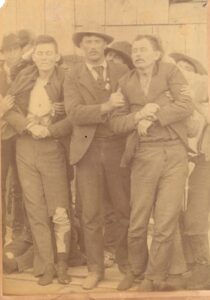 Unfortunately for the Daltons, they were recognized and the word quietly spread that the town banks were being robbed. The townspeople ran for their guns and surrounded the two banks. When the Dalton brothers walked out of the bank, a hail of bullets forced them back into the building. Regrouping, they tried to flee out the back door of the bank, but the townspeople were waiting for them there as well.
Unfortunately for the Daltons, they were recognized and the word quietly spread that the town banks were being robbed. The townspeople ran for their guns and surrounded the two banks. When the Dalton brothers walked out of the bank, a hail of bullets forced them back into the building. Regrouping, they tried to flee out the back door of the bank, but the townspeople were waiting for them there as well.
Meanwhile, in the Condon Bank a cashier had managed to delay Grat Dalton, Powers, and Broadwell with the claim that the vault was on a time lock and couldn’t be opened. That gave the townspeople enough time, and suddenly a bullet smashed through the bank window and hit Broadwell in the arm. The three men bolted out the door and fled down a back alley. But they were immediately shot and killed, this time by a local livery stable owner and a barber.
When the gun battle was over, the people of Coffeyville had destroyed the Dalton Gang, killing every member except for Emmett Dalton. But their victory was not without a price…The Dalton’s killed four of the townspeople.
John Wesley Hardin Kills Sheriff
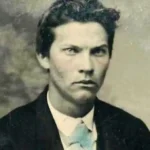 August 23, 1877 climaxed probably the most dramatic manhunt in the Old West. Although John Wesley Hardin had killed a number of men, on May 26, 1874 Hardin kills Sheriff Charles Webb in Texas and killing a lawman couldn’t be overlooked. Hardin was told that Webb wanted to kill him and capture his friend Jim Taylor. The encounter between Hardin and Webb was brief – a few words between the two men, an exchange of bullets, then Webb fell dead near the door of the Jack Wright Saloon. Hardin was wounded but escaped. For three years Hardin was able to elude the Texas Rangers by using an alias and keeping a low profile. He also moved to Florida.
August 23, 1877 climaxed probably the most dramatic manhunt in the Old West. Although John Wesley Hardin had killed a number of men, on May 26, 1874 Hardin kills Sheriff Charles Webb in Texas and killing a lawman couldn’t be overlooked. Hardin was told that Webb wanted to kill him and capture his friend Jim Taylor. The encounter between Hardin and Webb was brief – a few words between the two men, an exchange of bullets, then Webb fell dead near the door of the Jack Wright Saloon. Hardin was wounded but escaped. For three years Hardin was able to elude the Texas Rangers by using an alias and keeping a low profile. He also moved to Florida.
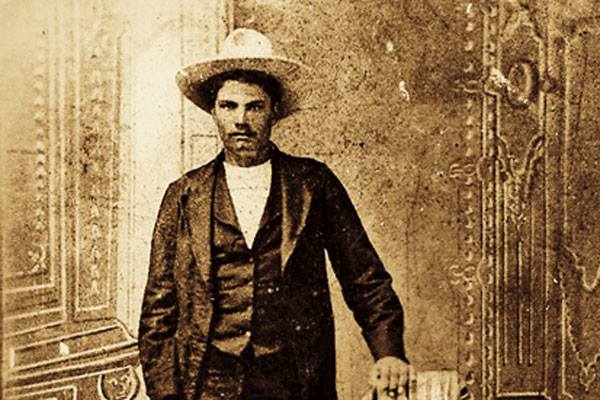 But, the Rangers discovered where he was, and even though they had no authority in Florida, sent John Armstrong after him. Acting on a tip, Armstrong spotted Hardin in the smoking car of a train stopped at the Pensacola station. Local deputies were stationed at both ends of the car, and the men burst in with guns drawn. Hardin reached for the gun holstered under his jacket. The pistol caught in Hardin’s fancy suspenders, this allowed Armstrong time to club Hardin with his long-barreled .45 pistol instead of having to shoot him.
But, the Rangers discovered where he was, and even though they had no authority in Florida, sent John Armstrong after him. Acting on a tip, Armstrong spotted Hardin in the smoking car of a train stopped at the Pensacola station. Local deputies were stationed at both ends of the car, and the men burst in with guns drawn. Hardin reached for the gun holstered under his jacket. The pistol caught in Hardin’s fancy suspenders, this allowed Armstrong time to club Hardin with his long-barreled .45 pistol instead of having to shoot him.
They spirited Hardin back to Texas on the next train. Hardin was tried and found guilty of killing Sheriff Webb and sentenced him to life in the Texas state prison at Huntsville. He served 15 years before the governor pardoned him.
Phoebe Ann Moses, aka Annie Oakley
This month we’ll be celebrating the birthday of Phoebe Ann Moses … If you don’t know who she is by the picture, it’s “Little Sure Shot,” Annie Oakley. Annie began trapping before age 7, and shooting and hunting by age 8, to support her siblings and her widowed mother. She sold hunted game to locals in Greenville, such as shopkeepers Charles and G. Anthony Katzenberger, who shipped it to hotels in Cincinnati and other cities. From the time she shot a squirrel for the family’s stew pot at the age of eight, she knew she had a special talent.
We all know about her talent, but what most people don’t know about is the love she and her husband had for each other, Frank Butler. Frank Butler was also a sharpshooter with his own traveling show. On Thanksgiving in 1876 they had a match, and Phoebe Ann Moses beat Frank. By June of the next year they were married in Oakley, Ohio. Phoebe Ann changed her name to “Annie Oakley”, and, as they say, the rest is history.
 Even though over the years, Annie Oakley’s popularity far outdistanced her husband’s, Frank’s love for Annie grew even more. And they were always together. After injuries from a train accident and later an auto accident she retired, and Annie and Frank moved to Greenville, Ohio. Annie Oakley died in 1926 at the age of 66. Frank Butler was so devastated that he stopped eating and died 18 days later.
Even though over the years, Annie Oakley’s popularity far outdistanced her husband’s, Frank’s love for Annie grew even more. And they were always together. After injuries from a train accident and later an auto accident she retired, and Annie and Frank moved to Greenville, Ohio. Annie Oakley died in 1926 at the age of 66. Frank Butler was so devastated that he stopped eating and died 18 days later.
Old West Vigilantes
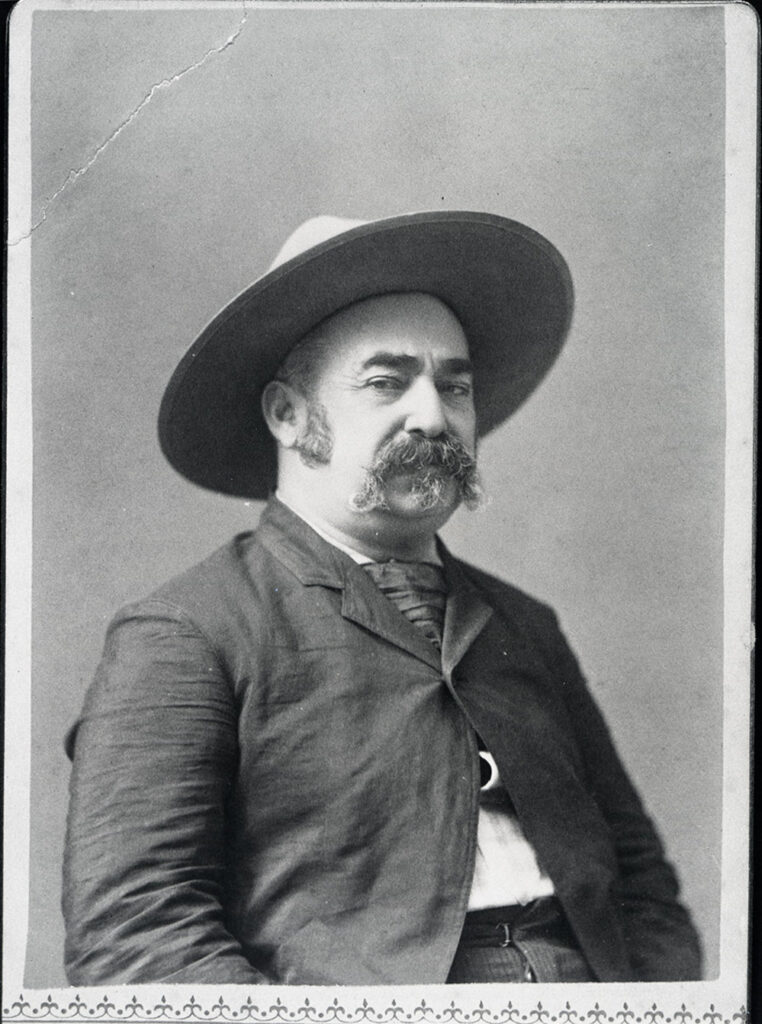 One of the aspects of the Wild West that has always intrigued me was the Old West vigilantes. I can understand the frustration with how many times crime was running rampant, with towns popping up ahead of the town’s infrastructure…which included the law.
One of the aspects of the Wild West that has always intrigued me was the Old West vigilantes. I can understand the frustration with how many times crime was running rampant, with towns popping up ahead of the town’s infrastructure…which included the law.
And even in more developed towns, the law was handicapped because of the number of lawmen, the territory they had to cover, the technology and even that sometimes the lawmen were also the outlaws.
Probably the most amazing aspect of the vigilantes is that they were usually known by everyone…sometimes pictures were taken…yet I’m not aware of any vigilante being tried for his actions.
Why am I talking about this at this time? This is the birthday of one of the most famous Old West vigilantes, John X. Beidler or just “X” as he was known by everyone.
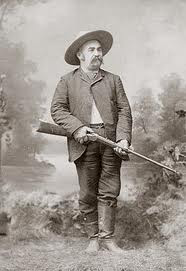 He was a leader of the Montana vigilantes. Unlike most vigilantes, who tried to remain unknown, X relished the notoriety. He was the principal hangman for at least five of the vigilante’s victims, and he survived several narrow escapes in his relentless pursuit of dangerous men.
He was a leader of the Montana vigilantes. Unlike most vigilantes, who tried to remain unknown, X relished the notoriety. He was the principal hangman for at least five of the vigilante’s victims, and he survived several narrow escapes in his relentless pursuit of dangerous men.
After Montana was rid of “The Innocents”…the name of the outlaw gang…the vigilantes disbanded. As an old man X fell on hard times and lived off the charity of people who remembered his service as a vigilante.
When he died in Helena, Montana, in 1890, his death certificate listed his occupation as “Public Benefactor.”
The James Gang’s Northfield Raid
 The movies show frontier town folk as being meek and easily intimated. But this was not so. These were people who were tough enough to brave the trip to the frontier, as well as being tough enough to endure frontier life. And after 1865 many were ex-soldiers. A good example of the toughness of the frontier people is the James Gang’s Northfield Raid that took back in 1876 on September 7.
The movies show frontier town folk as being meek and easily intimated. But this was not so. These were people who were tough enough to brave the trip to the frontier, as well as being tough enough to endure frontier life. And after 1865 many were ex-soldiers. A good example of the toughness of the frontier people is the James Gang’s Northfield Raid that took back in 1876 on September 7.
The James-Youngers were the “cock of the walk.” They were robbing everything in sight. And even though the famous Pinkerton Detective Agency was after them, the Pinkertons were stymied at every turn. So, the gang decided to go to Northfield, Minnesota and rob a bank there.
At the First National Bank, they demanded the money from the vault and Joseph Lee Heywood, the bank clerk on duty, was killed when he refused to open the safe. When the townspeople were alerted they attacked the robbers, defending their town and their savings. In the melee that followed, Nicholas Gustavson, a Swedish town resident, was killed, as were gang members Clell Miller and William Stiles.
The pursuit of the gang went on for weeks and covered 400 miles. The Youngers were eventually captured at Madelia, Minnesota, in another gun battle, in which gang member Charlie Pitts was killed. The three Younger brothers were tried in Faribault, found guilty of murder, and sentenced to life in the state prison at Stillwater.
The citizens of Northfield surrounded the bank and shot the robbers as they tried to escape. The result was that, with the exception of Jesse and Frank James, the gang was either shot up in Northfield or was captured by a posse some two weeks later.
It seems there was another gang known as the Daltons who had a similar problem in Coffeeville, Kansas.
Benjamin Singleton and the “Colored Exodus”
 It was early 1877. The Civil War had been over for more than ten years. But blacks still didn’t have the freedom they had hoped for. Tenant farming had replaced the plantation system. Because of the price of rented land, and supplies, the black farmer seldom broke even at the end of the year. So, they started looking for somewhere else that would give them true opportunity. Prior to the Civil War, by the vote of the residents, Kansas had changed from a slave to a free state. Although blacks had moved to Kansas on an individual basis, the first serious attempt to establish a black colony was on March 5, 1877 when Benjamin Singleton led a group from Tennessee to Baxter Springs located in the southeast corner of the state. Cherokee County Colony, Singleton Colony, Hill City, and Nicodemus Town followed. Most failed because of poor leadership, the transient nature of the emigrants, and having only marginal land available for settling.
It was early 1877. The Civil War had been over for more than ten years. But blacks still didn’t have the freedom they had hoped for. Tenant farming had replaced the plantation system. Because of the price of rented land, and supplies, the black farmer seldom broke even at the end of the year. So, they started looking for somewhere else that would give them true opportunity. Prior to the Civil War, by the vote of the residents, Kansas had changed from a slave to a free state. Although blacks had moved to Kansas on an individual basis, the first serious attempt to establish a black colony was on March 5, 1877 when Benjamin Singleton led a group from Tennessee to Baxter Springs located in the southeast corner of the state. Cherokee County Colony, Singleton Colony, Hill City, and Nicodemus Town followed. Most failed because of poor leadership, the transient nature of the emigrants, and having only marginal land available for settling.
It’s estimated that between fifteen and twenty thousand blacks migrated to Kansas in just a two-month period. Realizing the loss of cheap labor, southern landowners tried to stop the migration with intimidation and attacks against those involved in the “Colored Exodus.”
The biggest obstacle for blacks was that they had little or no money when they started their trek to Kansas. Many had only the possessions they could carry on their backs. However, they were assisted with relief efforts along the route from churches and private citizens.
By 1879 word got back to the south that the Kansas immigrants were facing tremendous problems in establishing a new life, and almost as fast as it started, the Kansas immigration dropped off to a trickle, and stopped.
Old West Gamblers
 Old West gamblers who came out west wagered everything on the hopes of becoming prosperous and having a good life. That same spirit led them into gambling halls, and games of chance. One such game started on June 15, 1853 and ended 24 years later.
Old West gamblers who came out west wagered everything on the hopes of becoming prosperous and having a good life. That same spirit led them into gambling halls, and games of chance. One such game started on June 15, 1853 and ended 24 years later.
For people of the Old West gambling was a way of life. They risked their life by going into Indian Territory for furs, precious metal or land. They staked everything they owned on a herd of cattle being driven north. And for sure they enjoyed a game of chance.
There was faro, euchre, monte, casino, and, of course, poker…which, incidentally, was always dealt to the left of the player to make it easier to pull a gun with the right hand in case of irregularities. The origin of most games of chance came from Europe, with the exception of the old three walnuts and a pea, which started in America, probably on the streets of New York, where it still prospers.
Not only did cowboys loose their wages, but whole herds of cattle, and a cattleman’s entire wealth would change hands over night. A few wives were even offered to “match the pot.”
On June 15, 1853, in Austin, Texas Major Danelson and Mr. Morgan sat down to play poker, and evidentially with little to go home to, forgot to quit. The game went on for a week… then a month… a year became years. The Civil War broke out, was fought and lost, but these two Texas gentlemen still dealt the cards. Finally in 1872, 19 years after it started, both men died on the same day…but the game continued. Their two sons took over, and played for 5 more years.
Finally the game ended in 1877 when a railroad train killed one of the sons, and the other went crazy. Not that all these Old West gamblers weren’t crazy in the first place.
Tombstone Stage Held Up
On March 15, 1881 the Tombstone stage was held up. Although not intended as such, it ended up being one of the causes for the O. K. Corral shootout. On the other hand, the two objectives of the hold-up were not accomplished.
The main objective was the assassination of Wells Fargo shotgun guard, Bob Paul. As a Wells Fargo guard, Bob Paul had hampered the activities of the cowboys. And, the word around town was that he was to become the Pima County Sheriff. So the cowboys wanted to get rid of him. The assassination failed because when the stage departed Tombstone, stage driver Budd Philpot had gotten stomach pains and Budd exchanged positions with Paul. Orders were to kill the guard…which they did, but it was Philpot instead of Paul.
Paul was also responsible for the robbers not accomplishing their second objective…the theft of $26,000 in silver. When Philpot was shot, Bob grabbed his shotgun and fired off both barrels. One robber was killed and the noise of the shotgun spooked the horses. As the stagecoach was careening out of control, Paul climbed down; secured the reigns of the runaway steeds; and brought the stage safely into Benson.
Later, when he did became the Pima County Sheriff this 6’ 6”, 240-pound mountain of a man, typically using a shotgun, brought in bad guys, stopped lynchings, and hanged many a man legally. It always seemed that he was able to dodge that fatal bullet…That is until 1893 when he couldn’t dodge the one called cancer, and he died on March 26, 1901.
Sequoyah
Sequohah, born in 1760 in Tennessee, grew up among his mother’s people, the Cherokee. He became a metal craftsman, making beautiful silver jewelry. As a young man he joined the Cherokee volunteers who joined Andrew Jackson in the War of 1812. While with the American soldiers, he became intrigued with what he called “talking leaves,” or words on paper that somehow recorded human speech. Although Sequohah had no formal education, he somehow comprehended the basic nature of the symbolic representation of sounds.
In 1809 he began working on a Cherokee language. At first he tried picture symbols, but soon found them to be impractical. Then he started looking at English, Greek and Hebrew. He finally developed 86 characters that would express the various sounds in the Cherokee language. It was so simple in its concept that it could be mastered in less than a week.
In 1821 he submitted his new written language to the Cherokee leaders. As a demonstration Sequohah wrote a message to his six-year-old daughter. She read the message and responded in kind. The tribal council immediately adopted the system. And Cherokee of all ages started learning the written language.
The Cherokee were divided into two groups, Sequohah’s in Georgia and Tennessee, and the western Cherokee in Oklahoma. In 1822 Sequohah went to Oklahoma, and taught the alphabet to the Cherokee there.
Finally, on February 21, 1828 the first printing press with Cherokee type arrived in Georgia. Within months, the first Indian language newspaper appeared. It was called the Cherokee Phoenix.
Sequohah later went to Mexico to teach Cherokee there the language. While in Mexico he became ill with dysentery, and died. Great monuments to the man who developed the Cherokee alphabet stand today along the northern California coast. They are the giant redwood trees called the Sequoia.
Pearl Hart and the Wild Old West
 Just when everyone thought the wild Old West was gone, in 1899 a small slight woman by the name of Pearl Hart and her boyfriend held up a stagecoach in the Florence, Arizona area.
Just when everyone thought the wild Old West was gone, in 1899 a small slight woman by the name of Pearl Hart and her boyfriend held up a stagecoach in the Florence, Arizona area.
Their take was a little over $400. But they weren’t able to spend it, because in a short time they were captured and jailed.
Shortly afterward, with the help of some men, Pearl escaped. But, because of her fame, she was recognized and returned to jail.
Pearl and her boyfriend were tried and convicted. The boyfriend got 30 years and Pearl got 5.
Pearl’s life after she got out of jail is surrounded in myth. Some say she became “The Arizona Bandit” with Buffalo Bill and in vaudeville. Others say she married a Calvin Bywater and settled down to a life of domestic bliss.
Whichever one it was, Pearl never got crosswise with the law again.
Antonio Lopez de Santa Anna Dies
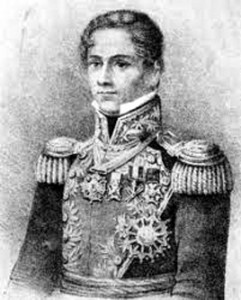 In 1876 Antonio Lopez de Santa Anna died. I know of no other Old West character whose life was more of a roller coaster.
In 1876 Antonio Lopez de Santa Anna died. I know of no other Old West character whose life was more of a roller coaster.
Born to middle-class parents in Mexico, as a teenager he joined the army. In 1821 he gained national prominence as a military leader in Mexico’s fight for independence against Spain.
This resulted in his being elected the President of Mexico in 1833. And just two years later he proclaimed himself the dictator of Mexico.
During this time the Anglos in the area that is now Texas were agitating for independence.
Determined not to let this happen, Santa Anna took command of the army and invaded Texas. As we all know Santa
Anna was captured and Texas became an independent republic.
While he was a captive of Texas, he was deposed. Eleven times over the next two decades, Santa Anna regained and lost his dictatorship. The last time was in 1855.
The once mighty Antonio Lopez de Santa Anna died embittered and impoverished.
William Quantrill Dies
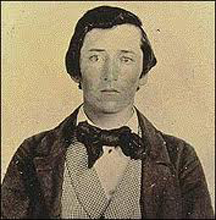 On June 6, 1865 William Quantrill dies of wounds encountered in a skirmish with Union Soldiers.
On June 6, 1865 William Quantrill dies of wounds encountered in a skirmish with Union Soldiers.
At one time I referred to Quantrill as a man without any redeeming qualities. I was promptly told not to go into the Deep South and say that. I may not return under my own steam.
William Quantrill was Frank and Jesse James’ mentor. He was born in Ohio and after getting into trouble in Utah and Kansas he fled to Missouri where he became a strong supporter of slavery, even getting into violent conflicts with neighbors.
When the Civil War broke out…It’s also referred to by some as “the war of Northern aggression”…he formed a group of gorilla irregulars. As indicated earlier, Frank and Jesse James were members of Quantrill’s Raiders.
Quantrill not only attacked Union forces, he would attack unguarded pro-Union towns; most notably Lawrence, Kansas where the raiders shot every man and boy they could find. After killing 150 civilians, they left the town ablaze.
Incidentally, since Quantrill’s guerillas weren’t considered legitimate soldiers, they were never given amnesty after the conclusion of the war.
Republic of California
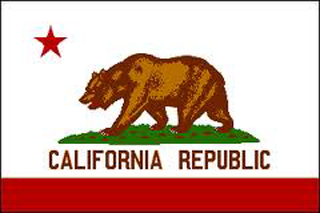 We all know that Texas was an independent republic before becoming a state. But did you know that California was an independent republic too? Here’s more about the Republic of California.
We all know that Texas was an independent republic before becoming a state. But did you know that California was an independent republic too? Here’s more about the Republic of California.
Although owned by Mexico, back in 1846 there were very few Mexican settlers in California. In reality there American settlers comprised the largest segment of the population.
On June 14, 1846, anticipating a war with Mexico, 33 Americans lead by William Ide invaded the Mexican outpost of Sonoma, north of San Francisco. They surrounded the home of Mexican General, Mariano Vallejo. With a bloodless victory, the Americans took a cotton sheet and with red paint they made a flag of a grizzly bear and single red star…A reference to the Texas Republic…and printed the words on the flag “California Republic”. The revolt was known as the Bear Flag Revolt.
Three weeks after California became an independent republic; American forces took control of Monterey and officially raised the American flag over California. Since this was what the American rebels wanted, they dissolved their government.
Incidentally, that Bear Flag became the official flag of California.
Warren Earp – Bringing a Knife to a Gunfight
 We’ve all heard about bringing a knife to a gunfight. Well, on this date back in 1900 that’s just what James, Morgan, Virgil and Wyatt’s little brother did.
We’ve all heard about bringing a knife to a gunfight. Well, on this date back in 1900 that’s just what James, Morgan, Virgil and Wyatt’s little brother did.
After participating in Wyatt’s ride of vengeance because of the cowboy’s wounding of Virgil and killing Morgan, Warren went to live with his parents in Colton, California.
With Warren regularly getting into trouble, his father got fed up with him and sent him packing. Warren ended up in Willcox, Arizona where he did a little cowboying and a lot of drinking. On July 6, 1900, Warren got crossways with a John Boyet. Some say it was because of a woman, others say it was a carry-over from the Tombstone days. In a confrontation, Warren kept pushing Boyet, until Boyet finally pulled his gun and killed Warren. This was a case of bringing a knife to a gunfight. For, it was discovered that Warren didn’t have a gun. But he did have a knife.
It seems that, to his dying day, Warren was trying to live up to the reputation of his brothers Wyatt and Virgil by being able to buffalo a man, and disarm him.
Old West Myth and Fact: Five Cartridges?
Here’s another Old West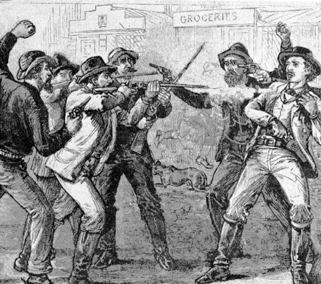 Myth and Fact. Tradition and the early Colt Pistol manuals says to load only five cartridges in a pistol and leave the empty cylinder under the hammer. The reason being if the hammer is accidently hit with a live cartridge under it, it could go off…Incidentally; modern pistols have a safety bar to prevent accidental firing.
Myth and Fact. Tradition and the early Colt Pistol manuals says to load only five cartridges in a pistol and leave the empty cylinder under the hammer. The reason being if the hammer is accidently hit with a live cartridge under it, it could go off…Incidentally; modern pistols have a safety bar to prevent accidental firing.
So, did they load only five cartridges? Not always. Wyatt Earp’s pistol fell to the floor in a saloon and it went off. Lawman Dallas Stoudenmire was being interviewed by a newspaper reporter. During the interview Dallas showed his shooting skills. The reporter said all six shots hit the target. A couple of years ago we published an article in Chronicle of the Old West from 1898 where two men went into the back room of a saloon, and while there a pistol was fired. The people in the saloon though it was a gun fight. Actually, one of the men dropped their pistol.
My feeling is if you were an average Joe you probably loaded five cartridges, but if there was a chance of gunplay you wanted as much firepower as possible. And that extra cartridge could mean the difference between life and death.
Jesse Chisholm Died of Food Poisoning
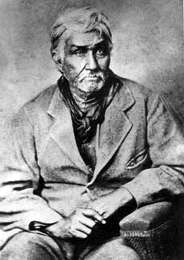 On March 4, 1868 Jesse Chisholm died of food poisoning.
On March 4, 1868 Jesse Chisholm died of food poisoning.
Even though the Chisholm Trail is known for its use during the cattle drive era, Jesse wasn’t a cattleman, but a frontier trader. He had a great knowledge of the southwest that was valuable in trailblazing.
Because he was a trader, Jesse Chisholm’s trail was a straight road with easy river crossings and few steep grades so lumbering heavy freight wagons would have no trouble traveling it.
He had originally used this trail to supply his various trading posts among the Native American tribes in Indian Territory, what is now western Oklahoma. He worked with Black Beaver, a Lenape guide, to develop the trail. Chisholm died before the peak period of the cattle drives from Texas to Kansas; but he was important to numerous events in Texas and Oklahoma history. He served as an interpreter for both the Republic of Texas and the United States government in treaty-making with Native American tribes.
A year before Chisholm died; his trail also began to be used for cattle drives. For five years, more than a million head of cattle traveled up the road, creating a path that was 200 to 400 yards wide. Traces of the trail can still be seen to this day.
End of Kansas Trail Drives
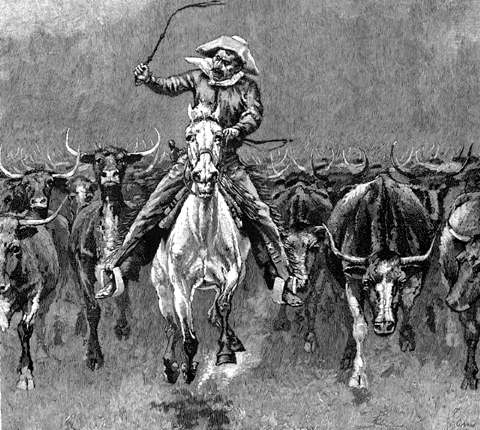 When it came to the Kansas Trail Drives, it seems that Kansas had a love-hate relationship with Texas cattle and the cowboys that brought them up.
When it came to the Kansas Trail Drives, it seems that Kansas had a love-hate relationship with Texas cattle and the cowboys that brought them up.
The love part was the profits to be made providing supplies to the cattle drives and a good time to trail-weary cowboys. Frontier struggling towns like Dodge City, Caldwell, Ellsworth, Hays, and Newton competed with Abilene to be the top “Cow Town” of Kansas.
But, as Kansas started getting less “frontier” and farming became more important, residents, anxious to attract businesses other than saloons and places of ill repute, started getting less enamored with the Texas cattle industry.
Although the Texas cattlemen tried to stay away from cultivated farmland, according to one cowboy “there was scarcely a day when we didn’t have a row with some settler.”
In addition to this, the Texas cattle carried a tick fever and hoof-and-mouth disease for which they were immune, but the Kansas cattle weren’t.
So, on this date back in 1885 the Kansas Legislature passed a bill that barred Texas cattle from the state between March and December 1.
This, along with the closing of open range with barbed wire fences, signaled an end to the cattle drives to Kansas.
The Prospector and the Gunfighter
Here’s the story of the Prospector and the Gunfighter, with not one, but five lessons for each of us:
An old prospector shuffled into town leading a tired old mule. The old man headed straight for the only saloon to clear his parched throat.
He walked up and tied his old mule to the hitch rail. As he stood there, brushing some of the dust from his face and clothes, a young gunslinger stepped out of the saloon with a gun in one hand and a bottle of whiskey in the other.
The young gunslinger looked at the old man and laughed, saying, “Hey old man, have you ever danced?”
The old man looked up at the gunslinger and said, “No, I never did dance. Never really wanted to.”
A crowd had gathered as the gunslinger grinned and said, “Well, you old fool, you’re gonna dance now,” and started shooting at the old man’s feet.
The old prospector — not wanting to get a toe blown off — started hopping around like a flea on a hot skillet. Everybody was laughing, fit to be tied.
When his last bullet had been fired, the young gunslinger, still laughing, holstered his gun and turned around to go back into the saloon.
The old man turned to his pack mule, pulled out a double-barreled shotgun, and cocked both hammers.
The loud clicks carried clearly through the desert air. The crowd stopped laughing immediately.
The young gunslinger heard the sounds too, and he turned around very slowly. The silence was almost deafening.
The crowd watched as the young gunman stared at the old timer and the large gaping holes of those twin barrels.
The barrels of the shotgun never wavered in the old man’s hands, as he quietly said, “Son, have you ever kissed a mule’s ass?”
The gunslinger swallowed hard and said, “No sir. But — I’ve always wanted to.”
There are a few lessons for us all here:
1 – Never be arrogant.
2 – Don’t waste ammunition.
3 – Whiskey makes you think you’re smarter than you are.
4 – Always, always make sure you know who has the power.
5 – Don’t mess with old men; they didn’t get old by being stupid.
Pearl Grey, Future Old West Author
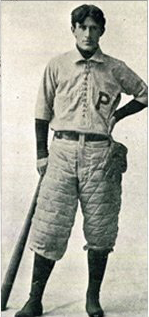 Today’s story is about a man who was a dentist. But he gave up his career to go out west and gain fame in a completely different profession. Do you think you know the person I’m talking about? You may be surprised: Pearl Grey was born on January 31, 1872. He was a talented baseball player, and played for the University of Pennsylvania while getting a degree in dentistry. Pearl was scheduled to follow in his father’s footsteps as a dentist. Looking for some excitement, he played some semi-pro baseball. But that didn’t satisfy his need.
Today’s story is about a man who was a dentist. But he gave up his career to go out west and gain fame in a completely different profession. Do you think you know the person I’m talking about? You may be surprised: Pearl Grey was born on January 31, 1872. He was a talented baseball player, and played for the University of Pennsylvania while getting a degree in dentistry. Pearl was scheduled to follow in his father’s footsteps as a dentist. Looking for some excitement, he played some semi-pro baseball. But that didn’t satisfy his need.
Incidentally, Pearl Grey never liked his first name, which was thought by everyone to be a woman’s name. So he decided to change it to his mother’s maiden name, Zane.
Pearl Zane Grey (January 31, 1872 – October 23, 1939) was an American author and dentist best known for his popular adventure novels and stories associated with the Western genre in literature and the arts; he idealized the American frontier. Riders of the Purple Sage (1912) was his best-selling book.
In addition to the commercial success of his printed works, his books have had second lives and continuing influence when adapted as films and television productions. His novels and short stories have been adapted into 112 films, two television episodes, and a television series, Dick Powell’s Zane Grey Theater.
A Duel With The Cactus
September 2, 1892, Daily Herald, El Paso, Texas – “Halt! What’s that?” said our leader in a sharp whisper.
It was a clear moonlight night in the extreme southwest of Mexico.
I was visiting a friend who conducted a large ranch and hacienda there.
A local revolt had just been quelled in the neighborhood and a spirit of lawlessness still pervaded the atmosphere. Only the night before my friend had been fired upon and one of his storehouses robbed by a band of Indians some fifteen or twenty strong. Early in the morning four of us, under the leadership of our host, had set out upon the track of the robbers.
We were well mounted, and resting only a few hours at noon had followed hard after them in a fair field we could drive them into quarters like cows to a pen, but we had no mind to run into a trap in the dark with five against fifteen; hence caution.
“Halt! What’s that?” our leader had whispered. We had come to the edge of a dense woods, and across an open space, upon the brow of a low sand hill, clearly outlined in the moonlight against the sky, we had discovered a dozen or more half naked fellows, with their arms extended in every direction, engaged in some sort of a weird, fantastic dance.
We could not see their legs, for the tops of the trees beyond the hill rose waist high, making a black background, but their arms moved slowly to and fro and we could easily imagine their legs keeping company.
“Those are the thieves!” our host muttered. “I know them, even at night. You fellow just come to the edge of the wood, where they can see you without knowing how many there are of you, and I’ll have them down here in no time.”
He rode out alone to the foot of the hill.
It required no little courage, and we watched him with proportionate admiration.
The figures did not cease their dance or notice him. Suddenly, with his rifle at his shoulder, he called to them: “I have you there! If one of you moves I’ll shoot him dead!”
The wind had been blowing through the trees, so that we could not have heard their response, but fortunately at that moment it ceased, and in the deep silence which settled down upon the forest in such a momentary lull we waited for the result.
Every Indian suddenly ceased his dancing and stood like a statue outlined against the sky.
“Come down here now,” shouted our host. “Come quietly, too, for the first man who makes any trouble drops dead.”
We could hear a sound, as of a hurried consultation of some sort, going on upon the hill for a moment, but the wind sprung up again before we could distinguish a single voice, and to our utter astonishment the fellows actually began their solemn dance again.
“Come down or I’ll shoot!” roared our host, but they kept on dancing and he did shoot.
Then there was commotion enough. A wild cry, followed by a cloud of dust rose from the brow of the hill.
“Fire!” yelled our host, and we responded with a well aimed volley, while he whipped out his heavy revolver and gave them another peppering.
There was a perfect bedlam of screams from the hill, and the dust hid everything from the view. They were either coming down or running for their lives.
For us it was either fly or follow. We waited irresolutely for the word of our leader, when the dust settled and there stood the Indians, silently going on with their fantastic dance as though we were a hundred miles away.
With a fierce ejaculation our host put spurs to his horse and dashed up the hill. We followed, without command, to find him upon the summit, sitting on the ground beneath a line of gaunt and ghostlike prickly pears—the ungainly cactus of Mexico.
The extended along the brow of the hill, their naked, skeleton branches spreading out in every unaccountable way and swaying solemnly in the breeze.
Among the roots a multitude of burrows in the dry dust showed where the sand birds had been lying, half buried, and quietly sleeping; and it was their noisy yelp we heard when they were frightened away by our host’s duel with the cactus.e ungainly cactus of Mexico.
The extended along the brow of the hill, their naked, skeleton branches spreading out in every unaccountable way and swaying solemnly in the breeze.
Among the roots a multitude of burrows in the dry dust showed where the sand birds had been lying, half buried, and quietly sleeping; and it was their noisy yelp we heard when they were frightened away by our host’s duel with the cactus.
Indian Cures
 October 9, 1892, Call, San Francisco, California – In the depths of the forest, an Indian breaks his leg or arm, said Dr. Hingston is his address at the British Medical Association meeting at Nottingham. Splints of softest material are at once improvised. Straight branches are cut, of uniform length and thickness. These are lined with down-like moss or scrapings or shavings of wood or with fine leaves interlaid with leaves, if in summer; or with the curled-up leaves of the evergreen cedar or hemlock, in winter; and the whole is surrounded with withes of willow or osier or young birch. Occasionally it is the soft but sufficiently unyielding bark of the poplar or the bass wood. Sometimes when near the marshy margin of our lakes or rivers the wounded limb is afforded support with wild hay or reeds of uniform length and thickness. Thus is the genius of Indian cures.
October 9, 1892, Call, San Francisco, California – In the depths of the forest, an Indian breaks his leg or arm, said Dr. Hingston is his address at the British Medical Association meeting at Nottingham. Splints of softest material are at once improvised. Straight branches are cut, of uniform length and thickness. These are lined with down-like moss or scrapings or shavings of wood or with fine leaves interlaid with leaves, if in summer; or with the curled-up leaves of the evergreen cedar or hemlock, in winter; and the whole is surrounded with withes of willow or osier or young birch. Occasionally it is the soft but sufficiently unyielding bark of the poplar or the bass wood. Sometimes when near the marshy margin of our lakes or rivers the wounded limb is afforded support with wild hay or reeds of uniform length and thickness. Thus is the genius of Indian cures.
To carry a patient to his wigwam or to an encampment a stretcher is quickly made of four young saplings, interwoven at their upper ends, and on this elastic, springy couch the injured man is borne away by his companions. When there are but two persons and an accident happens to one of them two young trees of birch or beech or hickory are used. Their tops are allowed to remain to aid in diminishing the jolting caused by the inequalities of the ground. No London carriage maker ever constructed a spring which could better accomplish the purpose. A couple of crossbars preserve the saplings in position, and the bark of the elm or birch cut into broad bands and joined to either side forms an even bed. In this way an injured man is brought by his companion to a settlement, and often it has been found on arrival that the fractured bones are firmly united and the limb is whole again. This is affected in less time than with the whites, for the recuperative power of these children of the forest is remarkable. In their plentitude of health osseous matter is poured out in large quantities and firm union is soon affected.
The reparative power of the aborigines when injured is equaled by the wonderful stoicism with which they bear injuries and inflect upon themselves the severest torture. They are accustomed to cut into abscesses with pointed flint; they light up a fire at a distance from the affected part (our counter-irritation; they amputate limbs with their hunting-knives, checking the hemorrhage with heated stones, as surgeons were accustomed to do in Europe in the time of Ambrose Pare, and sometimes they amputate their own limbs with more sang fiord than many young surgeons will display when operating on others. The stumps of limbs amputated in this primitive manner are well formed, for neatness is the characteristic of all Indians’ handiwork.
The Indians are familiar with and practice extensively the use of warm fomentations. In every tribe their old women are credited with the possession of knowledge of local bathing with hot water and of medicated decoctions. The herbs they use are known to a privileged few and enhance the consideration in which their possessors are held.
The Turkish bath, in a simpler but not less effective form, is well known to them. If one of their tribe suffers from fever or from the effects of long exposure to cold a steam bath is readily improvised. The tent of deerskin is tightly closed, the patient is placed in one corner, heated stones are placed near him, and on these water is poured until the confined air is saturated with vapor. Any degree of heat and any degree of moisture can be obtained in this way. Europeans often avail themselves of this powerful sudatory when suffering from rheumatism.
The Indians have their herbs—a few, not many. They have their emetics and laxatives, astringents and emollients, all of which are proffered to the suffering without fee or reward. The “Indian teas,” “Indian balsams” and other Indian cures —the virtues of which it sometimes takes columns of the daily journals to chronicle— belong to nature and are not theirs. To the white man is left this species of deception.


